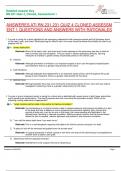Exam (elaborations)
ANSWERES ATI RN 231 231 QUIZ 4 CLONED ASSESSM ENT 1 QUESTIONS AND ANSWERS WITH RATIONALES
- Course
- Institution
ANSWERES ATI RN 231 231 QUIZ 4 CLONED ASSESSM ENT 1 QUESTIONS AND ANSWERS WITH RATIONALES 1. A nurse is caring for a client admitted to the emergency department with extensive partial and full-thickness burns of the head, neck, and chest. While planning the client's care, the nurse should be awa...
[Show more]



